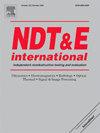基于MOEA/D-UR的超高速碰撞航天器损伤检测与评估红外特征提取
IF 4.5
2区 材料科学
Q1 MATERIALS SCIENCE, CHARACTERIZATION & TESTING
引用次数: 0
摘要
本文提出了一种基于分解的多目标进化算法随需更新权重(MOEA/D-UR)红外特征提取方法,用于损伤检测。由于超高速撞击(HVI)损伤的复杂性,在反射模式下,脉冲热成像很难直观地表征耦合缺陷。在得到多目标优化问题后,利用自适应度量来确定何时调整权重和划分目标空间。针对实际红外数据,引入了样本分布目标、数据结构目标和局部像素关系目标,并在此基础上建立了多目标优化问题。实验结果表明,该检测框架能够检测出不同的HVI损伤并实现视觉评价。该方法可以有效地对HVI引起的点冲击和表面冲击损伤进行分类。该方法成功地从250个选定的trs中识别出17个最优Pareto解,使用327,680像素的块。该检测框架在实际红外应用中表现出强大的性能,可以精确地识别出hiv诱导的缺陷区域。本文章由计算机程序翻译,如有差异,请以英文原文为准。
MOEA/D-UR based infrared feature extraction for hypervelocity impact spacecraft damage detection and assessment
In this paper, a decomposition-based multi-objective evolutionary algorithm updating weights when required (MOEA/D-UR) infrared feature extraction method is proposed for damage detection. Due to the complexity of the damage caused by hypervelocity impact (HVI), it is difficult to visually characterize the coupling defects in pulse thermography in reflection mode. After obtaining a multi-objective optimization problem, an adaptive metric was utilized to determine when to adjust the weights and divide the objective space. On the actual infrared data, we introduce the sample distribution objective, the data structure objective, and the local pixel relationship objective, based on which we establish a multi-objective optimization problem. The experimental results show that the detection framework is able to detect different HVI damages and realize visual evaluation. The proposed method can effectively classify point impact and surface impact damage caused by HVI. The method successfully identified 17 optimal Pareto solutions from 250 selected TTRs, using a block of 327,680 pixels. The detection framework demonstrates robust performance in practical infrared applications, precisely discriminating HVI-induced defective regions.
求助全文
通过发布文献求助,成功后即可免费获取论文全文。
去求助
来源期刊

Ndt & E International
工程技术-材料科学:表征与测试
CiteScore
7.20
自引率
9.50%
发文量
121
审稿时长
55 days
期刊介绍:
NDT&E international publishes peer-reviewed results of original research and development in all categories of the fields of nondestructive testing and evaluation including ultrasonics, electromagnetics, radiography, optical and thermal methods. In addition to traditional NDE topics, the emerging technology area of inspection of civil structures and materials is also emphasized. The journal publishes original papers on research and development of new inspection techniques and methods, as well as on novel and innovative applications of established methods. Papers on NDE sensors and their applications both for inspection and process control, as well as papers describing novel NDE systems for structural health monitoring and their performance in industrial settings are also considered. Other regular features include international news, new equipment and a calendar of forthcoming worldwide meetings. This journal is listed in Current Contents.
 求助内容:
求助内容: 应助结果提醒方式:
应助结果提醒方式:


